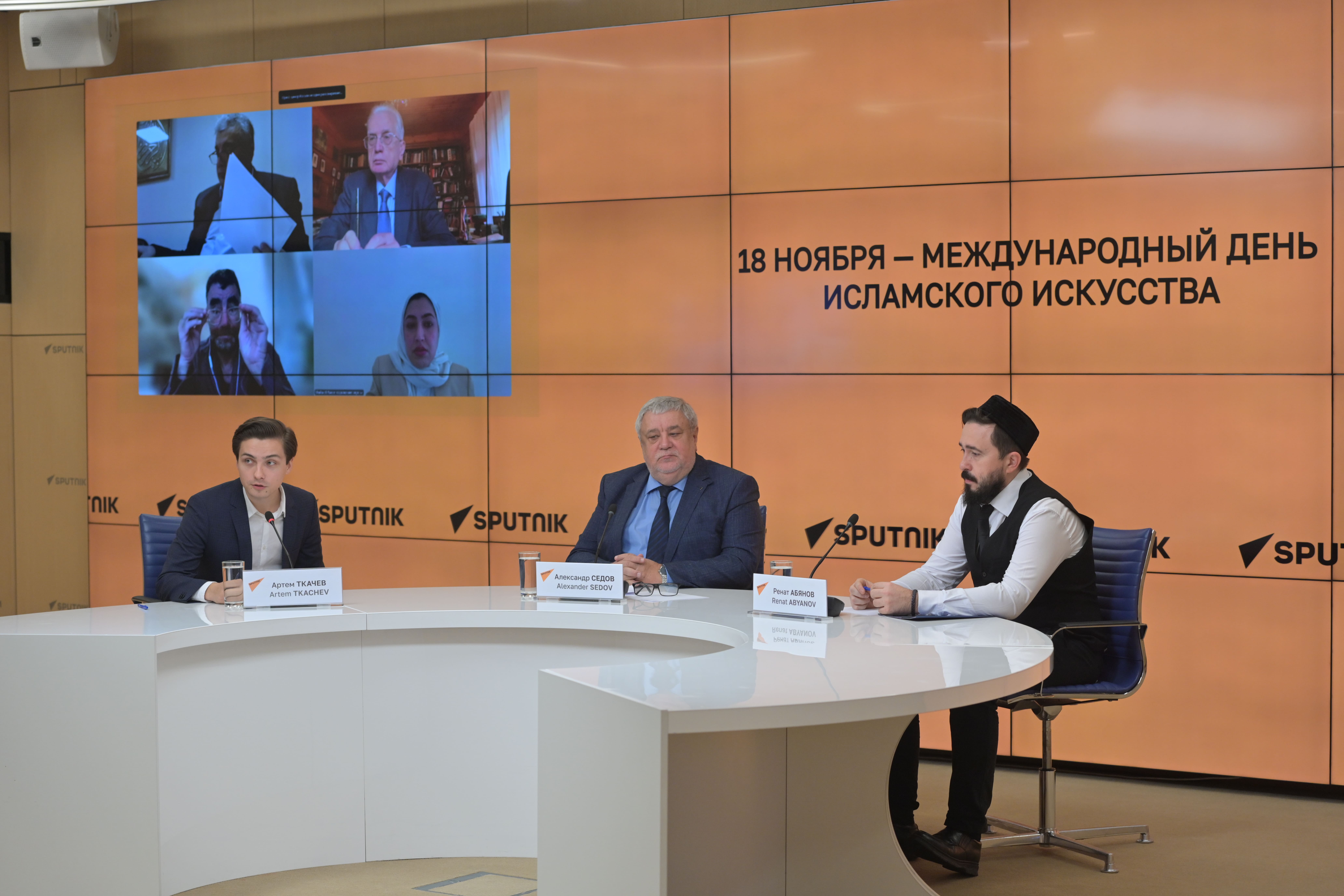Discussion Ahead of International Day of Islamic Art Brings Together Prominent Cultural Figures

Sputnik hosted a roundtable discussion ahead of November 18, the International Day of Islamic Art. Held as a videoconference, it gathered speakers from Moscow (Russia), St. Petersburg (Russia), Doha (Qatar), Beirut (Lebanon), Cairo (Egypt), and Damascus (Syria).
Speakers included State Hermitage Museum Director Mikhail Piotrovsky, Director of Qatar’s Museum of Islamic Art (MIA) Shaika Al-Nassr, Director General of the Museum of Oriental Art and Lead Research Fellow at the Institute of Oriental Studies of the Russian Academy of Sciences Alexander Sedov, Director and Founder of the Beirut Center of Photography, Lebanese-French photographer Patrick Baz, Head of the Culture Department at the Muslim Spiritual Authority of Russia and Imam at the Moscow Cathedral Mosque, ethnologist Renat Abyanov, and Deputy Editor-in-Chief of the Middle East News Agency Salah ad-din Maghawry.
The conversation focused on the latest trends in Islamic art and its future, with speakers covering several topics, including the way museums operate in this domain, Russia’s contacts with Arab countries and their joint cultural projects, as well as prospects for having more joint exhibition projects with Middle Eastern countries.
Mikhail Piotrovsky got the ball rolling by saying that Russia and Arab countries have generated considerable momentum in promoting their cooperation. The director of the State Hermitage Museum went on to elaborate on these projects and talked about working with Oman’s museum.
“We have developed a very positive relationship. The Hermitage Museum has an entire room devoted to Oman, while the Oman National Museum has its own room devoted to the Hermitage Museum. In fact, the Hermitage Museum will be launching its next Islamic art exhibition in Muscat in just a few days,” Mr. Piotrovsky pointed out.
He turned to other museums in the Gulf Region and the Hermitage Museum’s strong bonds with the museum in Qatar.
“We are preparing an exhibition on light and light fixtures in Islamic art and hope that the Qatar museum will share some of its exhibits with us.” Turning to cooperation with the UAE and Saudi Arabia, Mr. Piotrovsky, who also heads the St. Petersburg State University’s Oriental Studies Department, said that “there are ongoing consultations.” Mr. Piotrovsky also shared his take on the challenges museums face in today’s environment, arguing that “museums have always sought to preserve and safeguard culture during conflicts and other challenging situations.”
Director of the Museum of Islamic Art Shaika Al-Nassr discussed the importance of enabling museums to retain their role as an integral part of Qatar’s social fabric. Turning to international cooperation, she thanked Mikhail Piotrovsky for the opportunity to work with the State Hermitage Museum. She said that she was delighted to work with the Hermitage Museum and hoped that this cooperation carries on and brings about more joint exhibitions. Shaika Al-Nassr noted that the core mission of her museum consisted of preserving the cultural heritage of the Islamic world and proactively engaging with the public through educational programs by facilitating cultural exchanges and dialogue.
The floor then went to Director General of the Museum of Oriental Art Alexander Sedov, who said that his institution has presented Islamic art exhibitions every year. In 2025, it will hold two major exhibitions dealing with Islamic art and Russia’s role in it in various aspects.
“We will show more than 100 exhibits during the exhibition titled Masterpieces of Islamic Art, while paying special attention to Islamic art in Russia, i.e., in Dagestan, Crimea, and the Volga Region. This will be the first time the public discovers many of our exhibits after restoration,” Alexander Sedov pointed out, adding that there will also be an exhibition from the Patimat Gamzatova Dagestan Museum of Fine Arts as part of an exhibition project titled "Inspired by the Carpet at the Museum of Oriental Art."
Director of the Beirut Center of Photography Patrick Baz talked about the main stages in the development of photography as an art in the Middle East and posited that it is about to enter a new stage in its development. Having realized the importance of photography for Islamic art, they have been able to take a major step forward, he argued, adding that it has enabled them to build bridges between new and traditional artforms, explore the past and touch upon social issues, while challenging stereotypes, including the cultural stereotypes regarding the Global East.
Renat Abyanov focused on the Muslim Spiritual Authority’s cultural projects by placing a special emphasis on the Moscow International Quran Recitation Context. “Held for 22 years in Moscow, it has established itself as a prominent and respected platform with leading Quran scholars and researchers converging for this event. The contest won the prestigious Dubai Award as the best Quran recitation contest in a non-Arab country, which was a major achievement,” he said.
Deputy Editor-in-Chief of the Middle East News Agency Salah ad-din Maghawry stressed the importance of preserving Islamic cultural heritage with dedicated educational programs. He talked about the importance of promoting educational programs on Islamic art, including trainings, workshops and other initiatives, by reaching out to the public and its various social groups. In particular, this included promoting international cooperation and working with foreign partners on these projects, he pointed out.
Established by UNESCO’s 49th session in 2019, the International Day of Islamic Art is designed to raise awareness about Islam’s past and present artforms, as well as the Islamic culture’s contribution to our civilization through art.





